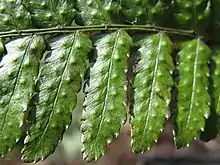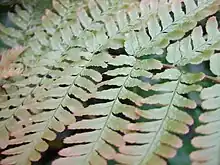Dryopteris erythrosora
Dryopteris erythrosora, the autumn fern or Japanese shield fern,[1] is a species of fern in the family Dryopteridaceae, native to east Asia from China and Japan south to the Philippines, growing in light woodland shade on low mountains or hills.[2]
| Dryopteris erythrosora | |
|---|---|
 | |
| Scientific classification | |
| Kingdom: | Plantae |
| Clade: | Tracheophytes |
| Division: | Polypodiophyta |
| Class: | Polypodiopsida |
| Order: | Polypodiales |
| Suborder: | Polypodiineae |
| Family: | Dryopteridaceae |
| Genus: | Dryopteris |
| Species: | D. erythrosora |
| Binomial name | |
| Dryopteris erythrosora (D.C.Eaton) Kuntze | |
Etymology
The specific epithet, erythrosora, is derived from two Ancient Greek words, ἐρυθρός (eruthrós) meaning red, and σωρός (sōrós) meaning heap.[3] So erythrosora literally means red heap, referring to the red sori on the undersides of the pinnules. The specific epithet may really be a reference to the red indusia, which cover the sori.[4]
Description

It is semi-evergreen (in cooler climates), with bipinnate fronds 30–70 cm (12–28 in) tall by 15–35 cm (6–14 in) broad, with 8–20 pairs of pinnae. The fronds have a coppery tint when young, but mature to dark green. It has an upright to down-lying rhizome which is thick and branched, so that it forms several crowns.
The leaves are funnel-shaped with the top ones being leathery shiny, divided twice, triangular in shape and pointy. The individual leaflets are narrow lanceolate. Its edge is almost completely sown up.
The leaf stalks are about a third as long as the leaf, striated, yellow to red, with linear to lancet-shaped brown scales, containing two large and several small vascular bundles in a cross-sectional drawing.
When budding, the young fronds are coppery red and later green. There can also be several leaf outlets per year. The spores, which are kidney-shaped, become ripe between summer and autumn.[5]
Cultivation
Dryopteris erythrosora can tolerate a drier soil than many ferns, but is most successful in moist, humus-rich soil, with a pH range of 6.1 to 7.5, with morning or late afternoon sunshine but not during the middle of the day.[6] It is hardy zones 5 to 11. Propagation is by division in spring, separating the small crowns from the larger crowns, or by spores. It is raised as an ornamental plant in gardens because of its color change in the foliage, which change from dark red to dark green, but not very often.[7]
D erythrosora[8] and the cultivar D. erythrosora 'Brilliance'[9] have gained the Royal Horticultural Society's Award of Garden Merit.[10]
References
- "Dryopteris erythrosora". Germplasm Resources Information Network. Agricultural Research Service, United States Department of Agriculture.
- The Natural History Museum of Los Angeles County Foundation: Dryopteris erythrosora
- "Dictionary of Botanical Epithets". Retrieved 17 July 2023.
- Horrocks, James R. (Fall 2003). "D. erythrosora" (PDF). Hardy Fern Foundation Quarterly. Vol. 13, no. 4. Medina, WA: Hardy Fern Foundation. p. 104. ISSN 1542-5517. Retrieved 17 July 2023.
The species name literally means "red sori", actually referring to the bright red indusia which covers the young sori.
- RHS A-Z encyclopedia of garden plants. United Kingdom: Dorling Kindersley. 2008. p. 1136. ISBN 978-1405332965.
- "Dryopteris erythrosora (Autumn Fern, Japanese Shield Fern, Shaggy Shield Fern) | North Carolina Extension Gardener Plant Toolbox". plants.ces.ncsu.edu. Retrieved 2021-02-22.
- Edward F. Gilman: Dryopteris erythrosis . Fact Sheet FPS-189, Environmental Horticulture Department, Florida Cooperative Extension Service, Institute of Food and Agricultural Sciences, University of Florida, 1999.
- "D. erythrosora". RHS. Royal Horticultural Society. 2023. Retrieved 17 July 2023.
- "D. erythrosora 'Brilliance'". RHS. Royal Horticultural Society. 2023. Retrieved 17 July 2023.
- "AGM Plants – Ornamental" (PDF). RHS. Royal Horticultural Society. April 2023. p. 40. Retrieved 17 July 2023.
![]() Media related to Dryopteris erythrosora at Wikimedia Commons
Media related to Dryopteris erythrosora at Wikimedia Commons